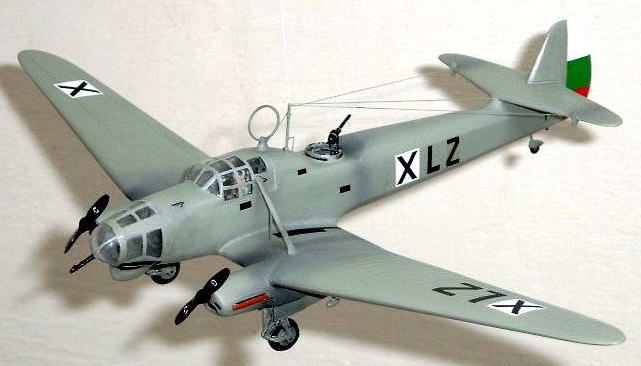
Airmodel 1/72 FW-58
| KIT #: | ? |
| PRICE: | ? |
| DECALS: | ? |
| REVIEWER: | Carmel J. Attard |
| NOTES: | Vacuformed |

| HISTORY |
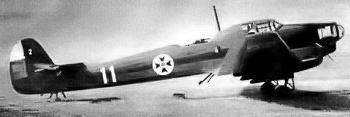 Bulgaria had an eventful history as
well as a dramatic one. Although boasted as a neutral country it was in fact a
very pro-German state long before the outbreak of the Second World War until it
eventually joined the axis on the 1st of March 1941. Between 1936 and
1941 the RLM itself supplied Bulgaria with a total of 203 aircraft of various
types including fighter-bombers and trainers, light attack and
reconnaissance aircraft.
Bulgaria had an eventful history as
well as a dramatic one. Although boasted as a neutral country it was in fact a
very pro-German state long before the outbreak of the Second World War until it
eventually joined the axis on the 1st of March 1941. Between 1936 and
1941 the RLM itself supplied Bulgaria with a total of 203 aircraft of various
types including fighter-bombers and trainers, light attack and
reconnaissance aircraft.
The earliest known involvement of
the FW-58 Weihe, which is more commonly known as Gulub, (meaning Pigeon)
in the Bulgarian Air Force inventory goes back to 1937. This was some time after
the Air Force received the 12 Dornier Do-11c heavy
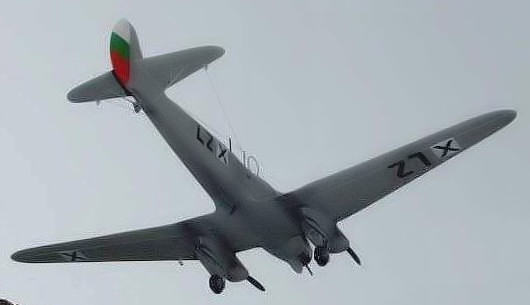 bombers along with two
FW-58Bs, which were delivered from Germany. The twin-engine
trainer/communication aircraft also came along with 12 Arado AR-65. The Gulub as
it came to be known in fact formed part of the small Army Air Force among the
eight Orliaks (Air Regiments) that evolved by September 1939, the period when
Germany invaded Poland. Eight FW-58 formed within the 5th Polk
(air-group) assigned to the Instrument Flying School at Plovdiv. NOTE: the 5th
Bomber Polk controlled two Orlyaks with a total of five Yata (squadrons) that
includes one for training. The FW-58 was used for a variety of roles, the
primary ones being photo mapping, instrument and multi-engines trainer roles.
Eventually apart from the Liaison /trainer duties the two versions FW-58B and
C-2s were armed and until 1944 were used in anti-partisan/ anti-guerilla role.
This gave rise to some losses and over-work and further small-scale delivery of
replacement aircraft, consisting of three FW-58 among other types, continued
until 1944. So the FW-58 could be used as a light bomber, recce aircraft, and
multi crew trainer. Fighter defense comprised a dorsal gun turret and a nose
attachment for rapid-firing rifle-caliber anti-aircraft weapon.
bombers along with two
FW-58Bs, which were delivered from Germany. The twin-engine
trainer/communication aircraft also came along with 12 Arado AR-65. The Gulub as
it came to be known in fact formed part of the small Army Air Force among the
eight Orliaks (Air Regiments) that evolved by September 1939, the period when
Germany invaded Poland. Eight FW-58 formed within the 5th Polk
(air-group) assigned to the Instrument Flying School at Plovdiv. NOTE: the 5th
Bomber Polk controlled two Orlyaks with a total of five Yata (squadrons) that
includes one for training. The FW-58 was used for a variety of roles, the
primary ones being photo mapping, instrument and multi-engines trainer roles.
Eventually apart from the Liaison /trainer duties the two versions FW-58B and
C-2s were armed and until 1944 were used in anti-partisan/ anti-guerilla role.
This gave rise to some losses and over-work and further small-scale delivery of
replacement aircraft, consisting of three FW-58 among other types, continued
until 1944. So the FW-58 could be used as a light bomber, recce aircraft, and
multi crew trainer. Fighter defense comprised a dorsal gun turret and a nose
attachment for rapid-firing rifle-caliber anti-aircraft weapon.
The order of battle in December 1949 suggested that among the reorganized units of the now pro-Russian air force was still equipped with the FW-58with the 6th fighter attack division. In fact four FW-58s were listed operating among Tu-2T, FW-189, assigned to the Mine-Torp Aviapolk based at Balchick. Another two formed part of a contingent of the 3rd. Advanced Training Squadron based at Talish.
| THE KIT |
 When I first started to build
vacform kits it used to be a mere challenge when compared to the more
conventional injection moulded kits. I say this because I soon realized that in
fact once you make two or more of these kits you will be so much hooked on them
that you start to look for kits offered in this category. One will soon
When I first started to build
vacform kits it used to be a mere challenge when compared to the more
conventional injection moulded kits. I say this because I soon realized that in
fact once you make two or more of these kits you will be so much hooked on them
that you start to look for kits offered in this category. One will soon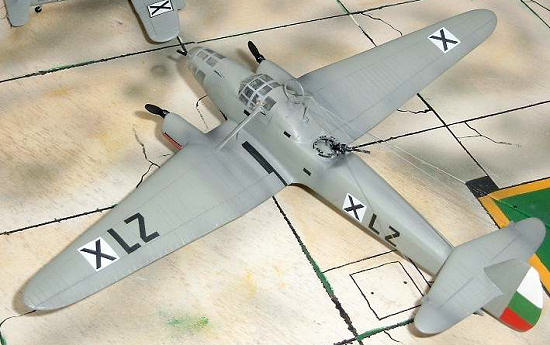 recognize that the little extra effort invested in building these kits is indeed
a worthwhile effort and rewarding since certain kits are only produced in this
manner. Until recently the FW-58 was a typical case for a long time as only in
past years a resin kit appeared on the market.
recognize that the little extra effort invested in building these kits is indeed
a worthwhile effort and rewarding since certain kits are only produced in this
manner. Until recently the FW-58 was a typical case for a long time as only in
past years a resin kit appeared on the market.
The Airmodel vacform kit of the FW-58 is one of the earliest kits to be released by this company. It is very unfortunate to note that the kit is no longer in production although the Airmodel new owner expressed with me the possibility of this kit being re-released at some time in future after some rework and possible resin detail parts added. One starts to wonder why it takes so long for even the injection moulding kit manufacturers to ignore and refrain from producing such a popular and graceful little twin engine WWII dual-purpose aircraft. The FW-58 has been neglected in preference to 109s, Spitfires and 190s etc which has been reproduced several times over. In spite of the rarity of the kit I managed to locate an example of one of these in a UK shop for a reasonable price.
| CONSTRUCTION |
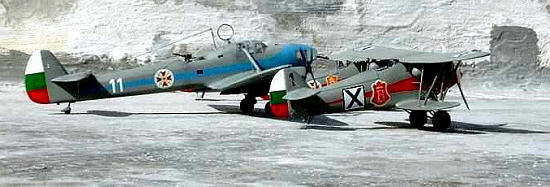 Moulded
in .7mm thick white plastic there are enough parts to make either of the two
versions, i.e. the B version with its glazed nose and the C version, which had a
solid nose front and faired over at rear of crew cockpit. The vacform
components, moulded on a sheet of plastic, provide for eight wing half pieces,
two fuselage halves, other six small components to form the Argus AS10c engines
and four clear acetate pieces to cater for the glazed nose and clear cockpit
canopy. A set of main wheel halves and tail wheel gives an indication of the
size of wheels required in case one prefer to replace these with an alternate
set from the spares box. There is enough detail for the less conspicuous pieces
as wheel oleo, struts, aerials, guns, and tail plane finlets to produce your own
from the extra sheet of plastic backing or using Contrail struts etc.
Moulded
in .7mm thick white plastic there are enough parts to make either of the two
versions, i.e. the B version with its glazed nose and the C version, which had a
solid nose front and faired over at rear of crew cockpit. The vacform
components, moulded on a sheet of plastic, provide for eight wing half pieces,
two fuselage halves, other six small components to form the Argus AS10c engines
and four clear acetate pieces to cater for the glazed nose and clear cockpit
canopy. A set of main wheel halves and tail wheel gives an indication of the
size of wheels required in case one prefer to replace these with an alternate
set from the spares box. There is enough detail for the less conspicuous pieces
as wheel oleo, struts, aerials, guns, and tail plane finlets to produce your own
from the extra sheet of plastic backing or using Contrail struts etc.
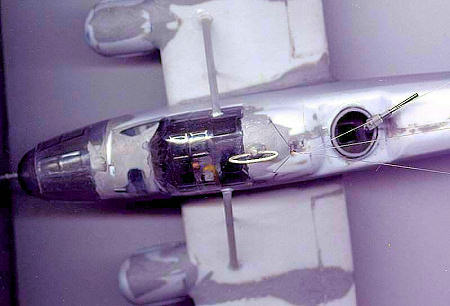 As the
different versions carry different antennae and colour schemes one will
preferably refer to photos of the particular aircraft type being modeled. A
generic layout and side views are included in the instruction sheet to enable
one to make the necessary alterations required to build either of the two
versions that served with the Luftwaffe AF. For instance the clear perspex
cockpit is extended to include the faired over aft in order to make the liaison
version, etc. Alternatively a gun emplacement is provided if the light bomber
version will be preferred. The same applies to the nose area. This can be
retained solid or cut to take a clear Perspex nose to correspond to the bomber/recce
version.
As the
different versions carry different antennae and colour schemes one will
preferably refer to photos of the particular aircraft type being modeled. A
generic layout and side views are included in the instruction sheet to enable
one to make the necessary alterations required to build either of the two
versions that served with the Luftwaffe AF. For instance the clear perspex
cockpit is extended to include the faired over aft in order to make the liaison
version, etc. Alternatively a gun emplacement is provided if the light bomber
version will be preferred. The same applies to the nose area. This can be
retained solid or cut to take a clear Perspex nose to correspond to the bomber/recce
version.
The
fitting of the glazed nose which I preferred to do, is not quite as
straightforward as one would desire and with a little care this
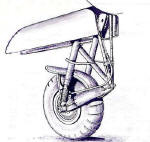 can be made to
one’s satisfaction. Interior detail is non-existent and one has to refer to
photos to arrive to reasonable detail information. One can therefore place
compartment sections and floor to take the basic seats, instrument panel,
control column, rudder pedals and some side levers or consoles. The
undercarriage well has to be detailed as it looks too bare if left as it is, I
have
can be made to
one’s satisfaction. Interior detail is non-existent and one has to refer to
photos to arrive to reasonable detail information. One can therefore place
compartment sections and floor to take the basic seats, instrument panel,
control column, rudder pedals and some side levers or consoles. The
undercarriage well has to be detailed as it looks too bare if left as it is, I
have
 attempted to detail mine as shown with addition of door webs, and a scratch
built detailed undercarriage assembly shown in photo made from different
thickness and short lengths of stretch sprue. I used Contrail struts to make the
upper wing struts and under tail-plane struts. No loop antenna is supplied with vacform kits unless a kit comes with resin detail parts. The FW-58 carried a
sizeable loop antenna and I have produced mine simply by stretching a heated
sprue coiled around a pencil with a diameter that matches the interior space of
the loop. Nose and dorsal guns were added from the spares box.
attempted to detail mine as shown with addition of door webs, and a scratch
built detailed undercarriage assembly shown in photo made from different
thickness and short lengths of stretch sprue. I used Contrail struts to make the
upper wing struts and under tail-plane struts. No loop antenna is supplied with vacform kits unless a kit comes with resin detail parts. The FW-58 carried a
sizeable loop antenna and I have produced mine simply by stretching a heated
sprue coiled around a pencil with a diameter that matches the interior space of
the loop. Nose and dorsal guns were added from the spares box.
| COLORS & MARKINGS |
As for the decals I have used ones produced from the Insignia range of decals with Maltese style roundel, which I made in preference to the X style ones in which I finished the kit as a first attempt, while lettering came from the spares box.
| CONCLUSIONS |
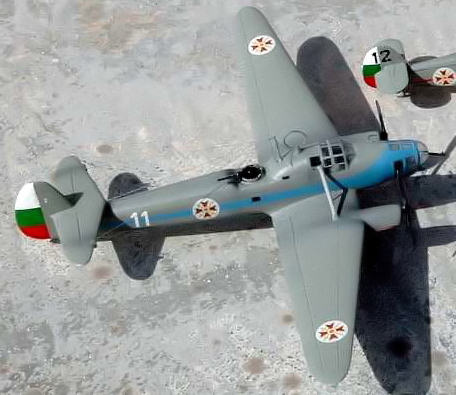 Considering that it was a straight from the box vacform kit it would be fair to
say that that each stage required careful alignment of parts and that a certain
amount of surgery was required during fit of parts. The end result was pleasing
as the photos would indicate, which bring another model to represent a FW-58 B
version that served with the Bulgarian Air Force, and was placed alongside other
aircraft kits like the Ar-65, and Do-11 of the same era. Somehow I have a soft
spot for aircraft that operated in the Bulgarian inventory. There was such a
variety of military aircraft in operational service especially over the war
years and also the Bulgarian air force seemed to have been overlooked for a long
period of time and much more information is emerging on the air forces of
Eastern Europe past history much of which was shrouded in secrecy during the
soviet era.
Considering that it was a straight from the box vacform kit it would be fair to
say that that each stage required careful alignment of parts and that a certain
amount of surgery was required during fit of parts. The end result was pleasing
as the photos would indicate, which bring another model to represent a FW-58 B
version that served with the Bulgarian Air Force, and was placed alongside other
aircraft kits like the Ar-65, and Do-11 of the same era. Somehow I have a soft
spot for aircraft that operated in the Bulgarian inventory. There was such a
variety of military aircraft in operational service especially over the war
years and also the Bulgarian air force seemed to have been overlooked for a long
period of time and much more information is emerging on the air forces of
Eastern Europe past history much of which was shrouded in secrecy during the
soviet era.
July 2006
Copyright ModelingMadness.com. All rights reserved. No reproduction in part or in whole without express permission. If you would like your product reviewed fairly and fairly quickly, please
contact
the editor or see other details in the
Note to
Contributors.